Related Research Articles
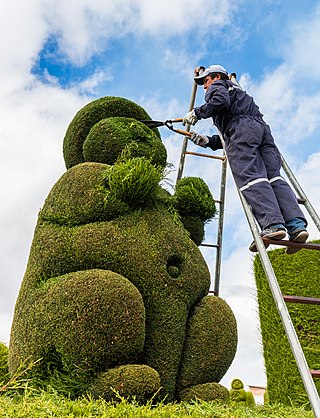
Topiary is the horticultural practice of training perennial plants by clipping the foliage and twigs of trees, shrubs and subshrubs to develop and maintain clearly defined shapes, whether geometric or fanciful. The term also refers to plants which have been shaped in this way. As an art form it is a type of living sculpture. The word derives from the Latin word for an ornamental landscape gardener, topiarius, a creator of topia or "places", a Greek word that Romans also applied to fictive indoor landscapes executed in fresco.
Vincenzo Ruffo was an Italian composer of the Renaissance. He was one of the composers most responsive to the musical reforms suggested by the Council of Trent, especially in his composition of masses, and as such was an influential member of the Counter-Reformation.
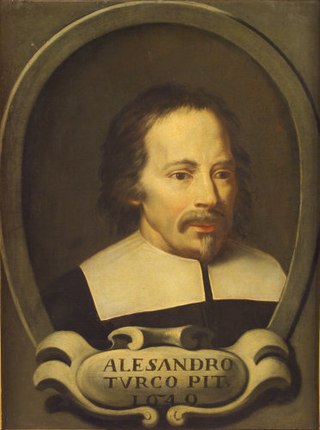
Alessandro Turchi was an Italian painter of the early Baroque, born and active mainly in Verona, and moving late in life to Rome. He also went by the name Alessandro Veronese or the nickname L'Orbetto. His style has been described as soft and Caravaggesque at the same time.
Jan Nasco was a Franco-Flemish composer and writer on music, mainly active in Italy. He was the first director of the Veronese Accademia Filarmonica, and his writings, particularly a group of letters he wrote to the academy in the 1550s, are important sources of information on performance practice regarding use of instruments in madrigals as well as motets.
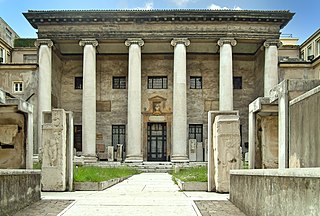
The Teatro Filarmonico is the main opera theater in Verona, Italy, and is one of the leading opera houses in Europe. The Teatro Filarmonico is property of the Accademia Filarmonica di Verona. Having been built in 1716, and later rebuilt after a fire of January 21, 1749, and again after the allied bombing of February 23, 1945.
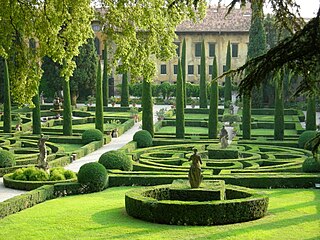
The Giusti Palace and Garden are located in the east of Verona, Italy, a short distance from Piazza Isolo and near the city centre. The palace was built in the sixteenth century. The garden is considered one of the finest examples of an Italian garden.
Benedetto Pallavicino was an Italian composer and organist of the late Renaissance. A prolific composer of madrigals, he was resident at the Gonzaga court of Mantua in the 1590s, where he was a close associate of Giaches de Wert, and a rival of his younger contemporary Claudio Monteverdi.
Francesco Portinaro was an Italian composer and humanist of the Renaissance, active both in northern Italy and in Rome. He was closely associated with the Ferrarese Este family, worked for several humanistic Renaissance academies, and was well known as a composer of madrigals and dialogues.
Antoine-Pierre de Bavier, also known as Antoine de Bavier and Anton von Bavier was a twentieth-century Swiss clarinettist and orchestral conductor.

Francesco Pona was an Italian medical doctor, philosopher, Marinist poet and writer from Verona, whose works ranged from scientific treatises and history to poetry and plays.
Ippolito Chamaterò was an Italian composer of the late Renaissance, originally from Rome but active in northern Italy. He wrote both sacred and secular music, particularly madrigals; all of his surviving music is vocal. His sacred musical style was in conformance with the Counter-Reformation musical ideals following the Council of Trent, and his madrigals were related stylistically to those of Adrian Willaert and Cipriano de Rore.

Italian garden typically refers to a style of gardens, wherever located, reflecting a number of large Italian Renaissance gardens which have survived in something like their original form. In the history of gardening, during the Renaissance, Italy had the most advanced and admired gardens in Europe, which greatly influenced other countries, especially the French formal garden and Dutch gardens and, mostly through these, gardens in Britain.
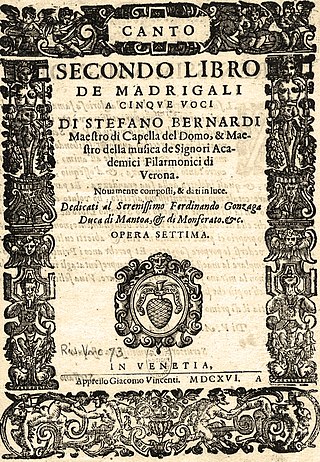
StefanoBernardi, also known as "il Moretto", was an Italian priest, composer and music theorist. Born in Verona and maestro di cappella at the Verona Cathedral from 1611 to 1622, he later moved to Salzburg, where he was responsible for the music at the Salzburg Cathedral and composed a Te Deum for 12 choirs performed at the cathedral's consecration in 1628.
Ippolito Baccusi was an Italian composer of the late Renaissance, active in northern Italy, including Venice, Mantua, and Verona. A member of the Venetian School of composers, he had a strong reputation as a master of counterpoint, and wrote both sacred and secular vocal music.
Lambert Courtois was a French composer, trombonist, and singer of the late Renaissance, active in Italy and Ragusa.
Luca Canonici is an Italian opera singer who has had an active career singing leading tenor roles both in Europe and his native Italy.
Accademia often refers to:
Lodovico Bellanda was an Italian composer and organist who lived in the transition period between the Renaissance and Baroque eras. He was born and worked most of his life in Verona, for which reason he was also known as Lodovico Veronese.
The following is a timeline of the history of the city of Verona in the Veneto region of Italy.
Agostino Giusti was an Italian diplomat in the service of the Medici and the Republic of Venice. He was also a notable patron of the arts and gardening.
References
- Francesco Pona: Sileno overo Delle Bellezze del Luogo dell'Ill.mo Sig. Co. Gio. Giacomo Giusti, 1620 Angelo Tamo, Verona
- Alfred Einstein, The Italian Madrigal. Three volumes. Princeton, New Jersey, Princeton University Press, 1949. ISBN 0-691-09112-9
- Paolo Villa: Giardino Giusti(it was one locations of the Accademia) 1993-94, pdf with maps and 200 photos
- Allan W. Atlas, Renaissance Music: Music in Western Europe, 1400–1600. New York, W.W. Norton & Co., 1998. ISBN 0-393-97169-4
- Gustave Reese, Music in the Renaissance. New York, W.W. Norton & Co., 1954. ISBN 0-393-09530-4
- "Accademia Filarmonica di Verona website". Accademia Filarmonica di Verona. 2011. Archived from the original on 2012-01-02. Retrieved January 6, 2012.